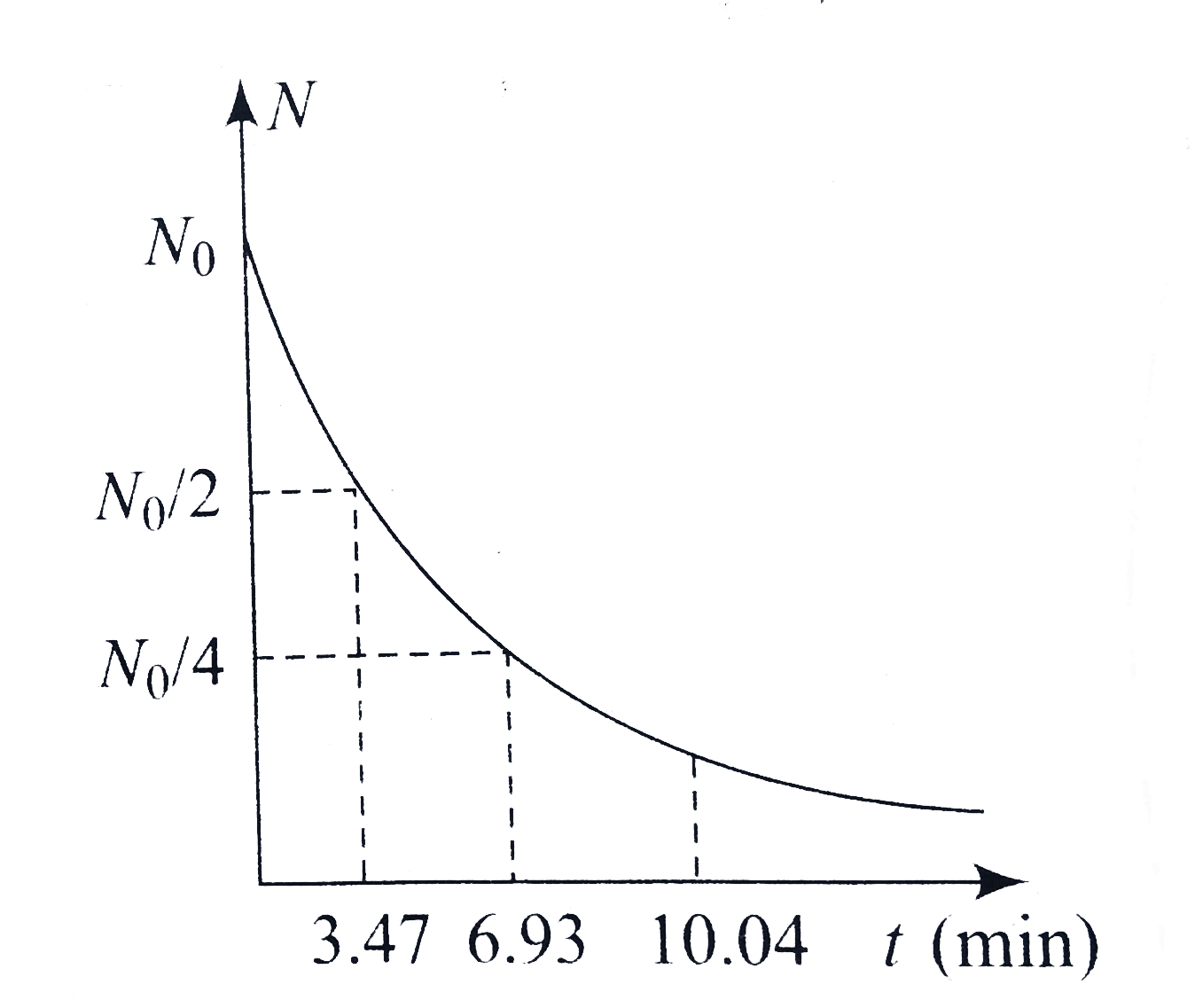Sample containing 23488Ra, which decays by α-particle emission, is observed to disintegrate at the following rate expressed as counts per minute (cpm). Calculate half-life of this nuclide. t=0, 1000 cpm, t=1h, 992 cpm, t= 10h, 924 cpm, t=100h, 452cpm, t= 250h, 138 cpm
The correct Answer is:3.63 days
Topper's Solved these Questions
- ATOMIC STRUCTURE AND RADIOACTIVITYBOOK - RC MUKHERJEECHAPTER - ATOMIC STRUCTURE AND RADIOACTIVITYEXERCISE - Objective Problems
66 Videos
- ATOMIC STRUCTURE AND RADIOACTIVITYBOOK - RC MUKHERJEECHAPTER - ATOMIC STRUCTURE AND RADIOACTIVITYEXERCISE - Objective Problems
66 Videos
- ATOMIC WEIGHTBOOK - RC MUKHERJEECHAPTER - ATOMIC WEIGHTEXERCISE - PROBLEMS
6 Videos
Similar Questions
A radioactive sample undergoes decay as per the following gragp. At timet=0, the number of undecayed nuclei is N0. Calculate the number of nuclei left after 1h.
 .
.
View SolutionA radioactive sample undergoes decay as per the following gragp. At timet=0, the number of undecayed nuclei is N0. Calculate the number of nuclei left after 1h.
 .
.
View Solution
Knowledge Check
A radioactive sample undergoes decay as per the following gragp. At timet=0, the number of undecayed nuclei is N0. Calculate the number of nuclei left after 1h.
 .AN0/e8BN0/e10CN0/e12DN0/e14
.AN0/e8BN0/e10CN0/e12DN0/e14The quantity of .14C as well as that of .14CO2 present in the atmosphere remains constant. The concentration of .14C in all living organisms remains almost constant during their life time. After their death, .14C is not taken up by them but the content of .14C assimilated begins to decay by emitting β− particles, with half-life period of 5568 years. The decay rate at the time of death of plant is 16.1counts per minute per gram of carbon. Hence, by measuring the decay rate of the dead matter, the age of matter can be calculated , e.g. if decay rate of sample of wood is found to be N distengrations per minute per gram of carbon after t years, then N=N0e−λt
where λ= disntegration constant and
N0= number of disntegrations per minute per gram when the plant had just died.
In a dead plant, the decay rate will beAhiger than in a living plantBlower than in a living plantCthe ratio of .14C/.12C which will increase in a dead plant as compared to a living plantDNone of the aboveThe quantity of .14C as well as that of .14CO2 present in the atmosphere remains constant. The concentration of .14C in all living organisms remains almost constant during their life time. After their death, .14C is not taken up by them but the content of .14C assimilated begins to decay by emitting β− particles, with half-life period of 5568 years. The decay rate at the time of death of plant is 16.1counts per minute per gram of carbon. Hence, by measuring the decay rate of the dead matter, the age of matter can be calculated , e.g. if decay rate of sample of wood is found to be N distengrations per minute per gram of carbon after t years, then N=N0e−λt
where λ= disntegration constant and
N0= number of disntegrations per minute per gram when the plant had just died.
.14C isAan artificial radioactive isotopeBa natural radioactive isotopeCa natural non-radioactive isotopeDan artifical non-radioactive isotope
A radioactive sample consists of two isotopes one of then decays by α− emission with a half life of τ1=405s and the other one decays by β emission with half life of τ1=1620s.Attimet=0,probabilitiesof≥∈galphaandbetapartic≤somthesamp≤areequal.<br>(a)Ifapartic≤comingoutofthesamp≤isdetectedatt=1620s,wˆistheprobabilitytˆitisalphapartic≤?<br>(b)F∈dthetimewhen→talνmberofsurviv∈gνc≤iishalfthe∈itialquantity.<br>GivenIfx^(4)+4x-2.5=0thenx=0.59<br>"log"_(10)2=0.301, "log"_(10)5.9=0.774
View SolutionA magnet makes 5 oscillations per minute in H=0.3×10−1T.By what amount the field should be increased so that the number of oscillations is 10 in the same time?
View SolutionA radioactive substance has a half-life of 64.8 h. A sample containing this isotope has an initial activity (t=0) of 40μCi. Calculate the number of nuclei that decay in the time interval between t1=10.0h and t2=12.0h.
View SolutionThe quantity of .14C as well as that of .14CO2 present in the atmosphere remains constant. The concentration of .14C in all living organisms remains almost constant during their life time. After their death, .14C is not taken up by them but the content of .14C assimilated begins to decay by emitting β− particles, with half-life period of 5568 years. The decay rate at the time of death of plant is 16.1counts per minute per gram of carbon. Hence, by measuring the decay rate of the dead matter, the age of matter can be calculated , e.g. if decay rate of sample of wood is found to be N distengrations per minute per gram of carbon after t years, then N=N0e−λt
where λ= disntegration constant and
N0= number of disntegrations per minute per gram when the plant had just died.
.14C is present in environmental because of
View SolutionThe quantity of .14C as well as that of .14CO2 present in the atmosphere remains constant. The concentration of .14C in all living organisms remains almost constant during their life time. After their death, .14C is not taken up by them but the content of .14C assimilated begins to decay by emitting β− particles, with half-life period of 5568 years. The decay rate at the time of death of plant is 16.1counts per minute per gram of carbon. Hence, by measuring the decay rate of the dead matter, the age of matter can be calculated , e.g. if decay rate of sample of wood is found to be N distengrations per minute per gram of carbon after t years, then N=N0e−λt
where λ= disntegration constant and
N0= number of disntegrations per minute per gram when the plant had just died.
The basis for carbon - 14 dating method is that the
View Solution
